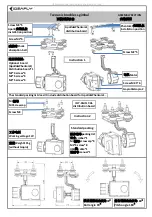
Ver.00
07 Febbraio 2019
14
3. Switch on the DC circuit breaker. At this point, the UPS will need to be started. Please refer to the
recommended process in the UPS User’s Manual. NOTE: If connecting more than one Battery Pack
please refer to the Daisy Chaining section.
CHARGING THE BATTERY
If the Battery Packs are plugged into an AC source and properly installed, the internal batteries will
be charged when acceptable voltage is provided. Battery Packs must be charged for a minimum of 6
hours before use. NOTE: If the Battery Pack is going to be out of service or stored for six months or
above, the batteries must be recharged for at least 36 hours every six months.
10
5.Extended Battery Pack Operation
The 1KVA-3KVA UPS System can be connected to multiple extended battery packs to increase the
runtime when connected to the UPS supporting the load. Most UPS Systems are limited to one or
two external battery packs because the UPS is responsible for the recharging and does not have the
recharge capacity to handle the additional batteries to a full recharge. The 1KVA-3KVA UPS System
overcomes this limitation by equipping each extended battery pack with its own charger, providing
the user a way to achieve significantly more battery backup time. Not all of the AC input power cords
for the Battery Pack need to be connected to AC - the more you connect the faster the recharge of
the batteries.
1.
The DC Circuit Breaker on the rear of the Battery Pack connects and disconnects the DC bus voltage from
the Battery Pack to the UPS. The DC Circuit Breaker will also trip to the OFF position in the event of an
over-current condition in the Battery Pack.
Figure 4 1KVA/2KVA/3KVA Battery Pack REAR VIEW
2.
The Battery Pack use a cable shipped with each Battery Pack to “daisy chain” together additional Battery
Pack to the first Battery Pack being connected to the UPS in the appropriately labeled connector, or for
connecting the first Battery Pack to the UPS.

































